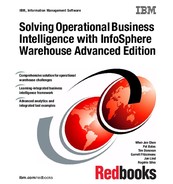Chapter 5. Temporal data management and analytics in an operational warehouse 181
For example, if an insurance policy is valid from the start of June 1 through the
month of June, then the inclusive-inclusive period will be expressed as June 1
through June 30. The end time includes all of June 30.
Inclusive-exclusive time period
Inclusive-exclusive indicates that a time period includes the first moment of the
start time (date or time stamp) and runs up until the first moment of the end time
(date or time stamp). This is also referred to as a closed-open period.
For instance, the example insurance policy mentioned that is effective for the
month of June requires a start time of June 1 and end time of July 1. The policy is
effective up to the first moment of July 1.
As discussed in the following section, DB2 manages time using
inclusive-exclusive time semantics. We now turn our attention to the new
temporal data management and query features in InfoSphere Warehouse 10.
5.2 Temporal data management in InfoSphere
Warehouse Advanced Enterprise Edition 10
The release of InfoSphere Warehouse 10, including the Advanced Enterprise
Edition, provides brand-new temporal data management and query features that
fully support the concepts and use cases described in the previous section.
These new features are based on the ISO SQL 2011 specifications for temporal
data support
2
. Built-in support for temporal data handling provides a consistent
and automatic means of handling temporal data and logic for applications.
Prior to InfoSphere Warehouse 10, it was necessary for DBAs and application
developers to develop custom programming, make use of DB2 triggers, or use
combinations of these techniques to implement similar temporal logic. Now it is
possible to take advantage of industry standard techniques and SQL syntax to
implement temporal awareness in the database and in applications that is more
seamless to applications and more easily implemented and maintained.
Temporal data management in InfoSphere Warehouse 10 covers the concepts of
both system time and business time. We discuss these in turn in the following
sections. We consider how the temporal tables are created, modified, queried
and maintained.
2
The International Organization for Standards (ISO) specifications for SQL are contained in multiple
parts. The relevant specifications are designated ISO/IEC 9075-n:2011 where n refers to the
specification part number. All ISO SQL 2011 specifications can be found at www.iso.org.
..................Content has been hidden....................
You can't read the all page of ebook, please click here login for view all page.
